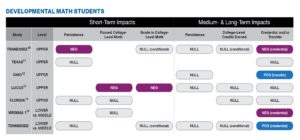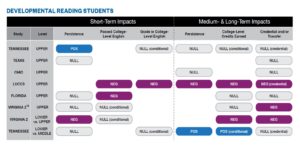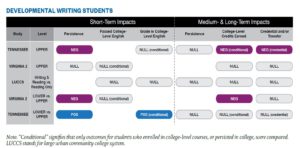The Goal of Remediation
Alexandros M. Goudas (Working Paper No. 1) December 2016
What are college remedial courses supposed to accomplish? The answer to this question is extremely important because it determines the benchmark for what is considered “success” for these courses. When remediation does not reach the accepted level of success, according to a researcher’s definition, then in many cases it is cut, or it is reformed to such an extent that it may harm student outcomes. Unfortunately, many researchers and policy experts have set the goal for remediation to be more strenuous than what should be expected based on what remedial courses are designed to cover. In fact, their determination runs counter to decades of theory and practice by experts in the field.
Again, this particular definition is crucial because a misinterpretation of remediation’s goal has already had a large hand in changing the fate of millions of students in higher education, mostly for the worse. Therefore, we need to investigate what remediation’s goal should be, what some researchers believe it is, and why it matters.
To begin, K. Patricia Cross published a book on higher education in 1971 called Beyond the Open Door, in which she discusses the challenge of the rising influx of thousands of underprepared students, dubbed “New Students” (pp. 2–12), into the higher education system in the late 1950s and 1960s. Cross describes the predominant view of community college educators working with these students at the time. In Appendix C in the back of the book, based on a survey of 141 two-year colleges (out of a total of approximately 900 existing at the time), respondents’ number one goal for remediation was “to prepare students for regular college work” (p. 192). That is, educators thought students who take remedial courses should be expected to perform equally as well in gatekeeper courses (first-year, first-semester, college-level courses, such as English Composition and College Algebra) when compared to students who place directly into those gatekeeper courses but who do not require remedial courses.
This definition of remediation’s goal seems intuitive to many educators, but more importantly, for decades now it has been accepted by experts in the field, notably, the National Center for Developmental Education’s former Director Hunter R. Boylan, a practitioner and researcher who helped establish the field itself. Nonetheless, it takes some explanation to understand why.
It is probably best to think about remediation as part of a sequence of tiered learning. Perhaps math as a subject is the quintessential example of tiered knowledge in action. In order for a student to understand how to solve college-level algebraic problems, that student must first understand more basic terms, processes, and equations, such as the order of operations, PEMDAS. It takes time to understand and practice these concepts before one applies them to more advanced calculations. A remedial math course is typically designed to address these concepts so as to prepare students to start college algebra with the necessary knowledge and practice. That way they should be able to pass college algebra at the same rate as other students who do not require remedial courses.
One of the best visual representations of tiered remediation can be found in an Institute for Education Sciences report entitled “Examining the Links Between Grade 12 Mathematics Coursework and Mathematics Remediation in Nevada Public Colleges and Universities” (2008). In Figure 3, Fong et al. plotted college remediation rates based on the type of math course students took in 12th grade and their GPA from that high school math course (p. 8).
What this means is that there is a direct relationship between the math course taken and passed in high school and the level of remediation students place into in college. Well over 50% of students place into remedial math in two-year colleges (Chen, 2016), a number which suggests most of these students are not taking Advanced I, II, or III math courses in high school. College remedial math courses, then, are simply replacements for the tiered math courses offered in high school, though remedial courses are often taught with a college-level pace and pedagogical style, according to the principles and methods of adult learning and development.
Another way to look at it is through the lens of the students who are not prepared for college-level material. No one would fault an older student who comes back to college, after working for perhaps ten to twenty years, for needing a brush-up on what they had in high school or college. Alternatively, if a traditional-aged student who never took advanced math courses in high school wished to attend college, they may need to take those courses in the form of remediation. Either way, these two types of students should be expected to perform similarly in college-level courses when compared other students who took college preparatory coursework in high school and who tested directly into college-level math and English. Remedial students are simply learning what they had learned and lost, or had never learned at all, in order to have the same chances at passing college-level courses as nonremedial students.
Unfortunately, however, researchers from the Community College Research Center (CCRC) and elsewhere have mistakenly espoused the idea that remedial students should perform better than nonremedial students in gateway courses. Indeed, they believe remedial students should outperform nonremedial students in all subsequent outcomes if remediation is to be considered beneficial. CCRC researchers Calcagno and Long (2008) outlined the CCRC’s accepted definition of the goal of remediation: “It would be expected that after successfully learning the skills needed for college-level work, a remedial student would be more likely than an academically-equivalent nonremedial student to complete [college-level] courses” (p. 16).
This is important because their definition has shaped how the CCRC and others across the nation have assessed remediation. In fact, the primary type of study that the CCRC uses to assess remedial outcomes is interpreted with this definition. CCRC researchers use a quasi-experimental design called regression discontinuity (RD) to study remedial student interventions. This means that whenever remedial students (those chosen who are statistically similar to nonremedial students, all of whom are located around a placement cutoff) do not perform better than nonremedial students in a subsequent metric, the CCRC dubs this a null result (a statistical term referring to the finding that the remedial students did not perform differently than the nonremedial students in the study, both of whom are just above and just beneath a placement cutoff score). Based on many different null results from numerous RD studies the CCRC has conducted, then, they have concluded that most remediation is ineffective.
An overview of many of the CCRC’s regression discontinuity studies on remediation can be found in Jaggars and Stacey (2014). In this report, one can view charts of the various outcomes of almost all of the CCRC RD studies they conducted (p. 3). Most of the studies’ results are marked as null, which is a reference to the null result described in the prior paragraph. Below are three charts containing an overview of their RD findings on remedial courses from many different states and institutions:
Again, the CCRC researchers expect students who take remedial courses to perform better in gateway courses and in other outcomes than students who never needed remediation. The null findings above mean both groups of students performed similarly in these outcomes. If the CCRC definition of the goal of remediation were changed to the accepted definition in the field, all the null results would be considered successes. In fact, when all math, reading, and writing RD studies the CCRC cited in these three charts are combined, only 20 out of the total of 79 RD studies show negative results. That would be a 75% success rate for remediation.
A thorough overview of the CCRC’s data and their interpretations of that data can also be found in this article (Bailey & Jaggars, 2016). However, the CCRC continues to publish research about remediation using the exact same experimental design and definition of remediation, the most recent being an article by Di Xu, which can be found in the journal Educational Researcher (2016). Unfortunately, Xu’s conclusions are based on RD cutoffs and do not control for other important factors that contribute a great deal to lower success rates for remedial students. Thus, along with almost every other researcher associated with the CCRC, Xu proclaims remediation to be an obstacle, or a barrier, which is a misunderstanding of uncontextualized data.
Aside from the statistical assessment of outcomes, understanding the curricula of remedial courses is important as well. If one were to accept the CCRC’s and others’ view that remedial courses should allow remedial students perform better than nonremedial students in subsequent gatekeeper courses, then one must also assume that remedial courses cover the nearly the exact same material as gatekeeper courses. However, no one has ever argued that remedial courses are a “light version” of college-level courses. In other words, a remedial course is not supposed to cover the same material that is in a college-level course but in a superficial way. It is instead supposed to cover concepts required for students to be ready to complete college-level material, i.e., prerequisites. Simply put, remediation is supposed to get students to the college-level starting line.
One approach that the CCRC has recommended regarding remedial curriculum is to “enhance the rigor” of these courses so that students are exposed to more college-level material (Barragan & Cormier, 2013). However, as most remedial educators know, it is very difficult to teach college-level composition concepts when a student is struggling with the formation of a basic paragraph or sentence. The same goes for math. It is near impossible to teach higher-order algebraic operations when a student has difficulty understanding basic the functions of fractions or multiplication. The role remedial courses have in providing a tiered, sequential curriculum that aligns with college-level courses is essential in higher education. No doubt, a great deal of energy should be invested in creating, assessing, and aligning proper curricula in remedial courses, but to suggest that institutions should shift remedial content to college-level content shows a misunderstanding of the real deficiencies many students bring with them to college.
Aside from Cross (1971) and Boylan (Boylan & Bonham, 2014), other researchers and experts define remediation as a set of courses designed to allow students to perform similarly to nonremedial students in subsequent outcomes. For example, in an article entitled “Revisiting the Efficacy of Postsecondary Remediation,” Peter Bahr (2010), from the University of Michigan, interprets null scores differently from the way the CCRC does. Based on his own study of remedial outcomes, Bahr concluded,
Skill deficient students who attain college-level English and math skill experience the various academic outcomes at rates very similar to those of college-prepared students who attain college-level competency in English and math. Thus, the results of this study demonstrate that postsecondary remediation is highly efficacious. (p. 199)
Bahr’s research, which shows similar performance outcomes of the two groups, remedial and nonremedial students, demonstrates that he views remediation as a success. It should be noted that in his study, Bahr used the exact same quasi-experimental RD design that the CCRC has used repeatedly, yet he came to entirely different conclusions because his interpretation of remediation’s goal is different.
The distinction matters significantly, and here is why: Ever since the CCRC began its focus on remediation in approximately 2007, article after article, report after report, and news release after news release have repeated the claim that remediation is ineffective. This is primarily due to the CCRC’s alternative definition of the goal of remediation that is not in line with the theory and practice of experts in the field. If the same RD datasets that the CCRC has were analyzed using the traditional and accepted definition of remediation’s goal, then remediation would not be viewed as so ineffective by so many people.
Perhaps, then, as a result of the revised definition of success, remediation in the nation would not be subject to restriction, excessive modification, or entire cuts. Some of these types of reforms are covered in other articles, but suffice it to say for now, many of them may be directly harming students, especially at-risk students and their opportunities to access courses at appropriate levels. We can do much better.
The other main reason that researchers claim that remediation is ineffective is because so few remedial students make it through remediation, take and pass gatekeeper courses, and then graduate. However, as with many claims about remediation that are currently accepted, these too need further investigation.
References
Bahr, P. R. (2010). Revisiting the efficacy of postsecondary remediation: The moderating effects of depth/breadth of deficiency. Research in Higher Education Journal, 33(2), 177–205. https://muse.jhu.edu/article/365583
Bailey, T. R., & Jaggars, S. S. (2016, June 2). When college students start behind. The Century Foundation. https://production-tcf.imgix.net/app/uploads/2016/05/01205852/TCF_WhenCollegeStudentsStartBehind.pdf
Barragan, M., & Cormier, M. S. (2013). Enhancing rigor in developmental education. Inside Out, Community College Research Center, Teachers College, Columbia University. https://ccrc.tc.columbia.edu/publications/enhancing-rigor-in-developmental-education.html
Boylan, H. R., & Bonham, B. S. (Eds.). (2014). Developmental education: Readings on its past, present, and future. Bedford/St. Martins.
Calcagno, J. C., & Long. B. T. (2008). The impact of postsecondary remediation using a regression discontinuity approach: Addressing endogenous sorting and noncompliance (An NCPR Working Paper). National Center for Postsecondary Research, Columbia University, Teachers College. http://www.nber.org/papers/w14194.pdf
Chen, X. (2016). Remedial coursetaking at U.S. public 2- and 4-year institutions: Scope, experiences, and outcomes (NCES 2016-405). U.S. Department of Education, Institute of Education Sciences, National Center for Education Statistics. https://nces.ed.gov/pubs2016/2016405.pdf
Complete College America. (2012). Remediation: Higher education’s bridge to nowhere. Bill & Melinda Gates Foundation. https://eric.ed.gov/?id=ED536825
Cross, P. (1971). Beyond the open door: New students to higher education. Jossey-Bass Inc.
Fong, A.B., Huang, M., and Goel, A.M. (2008). Examining the links between grade 12 mathematics coursework and mathematics remediation in Nevada public colleges and universities (Issues & Answers Report, REL 2008–No. 058). U.S. Department of Education, Institute of Education Sciences, National Center for Education Evaluation and Regional Assistance, Regional Educational Laboratory West. https://ies.ed.gov/ncee/edlabs/regions/west/pdf/REL_2008058_sum.pdf
Jaggars, S. S., & Stacey, G. W. (2014). What we know about developmental education outcomes [Research overview]. Community College Research Center, Teachers College, Columbia University. http://ccrc.tc.columbia.edu/media/k2/attachments/what-we-know-about-developmental-education-outcomes.pdf
Xu, D. (2016). Assistance or obstacle? The impact of different levels of English developmental education on
underprepared students in community colleges. Educational Researcher, 45(9), 496–507. http://ccrc.tc.columbia.edu/publications/assistance-or-obstacle-impact-different-levels-english-developmental-education-underprepared-students-community-colleges.html



